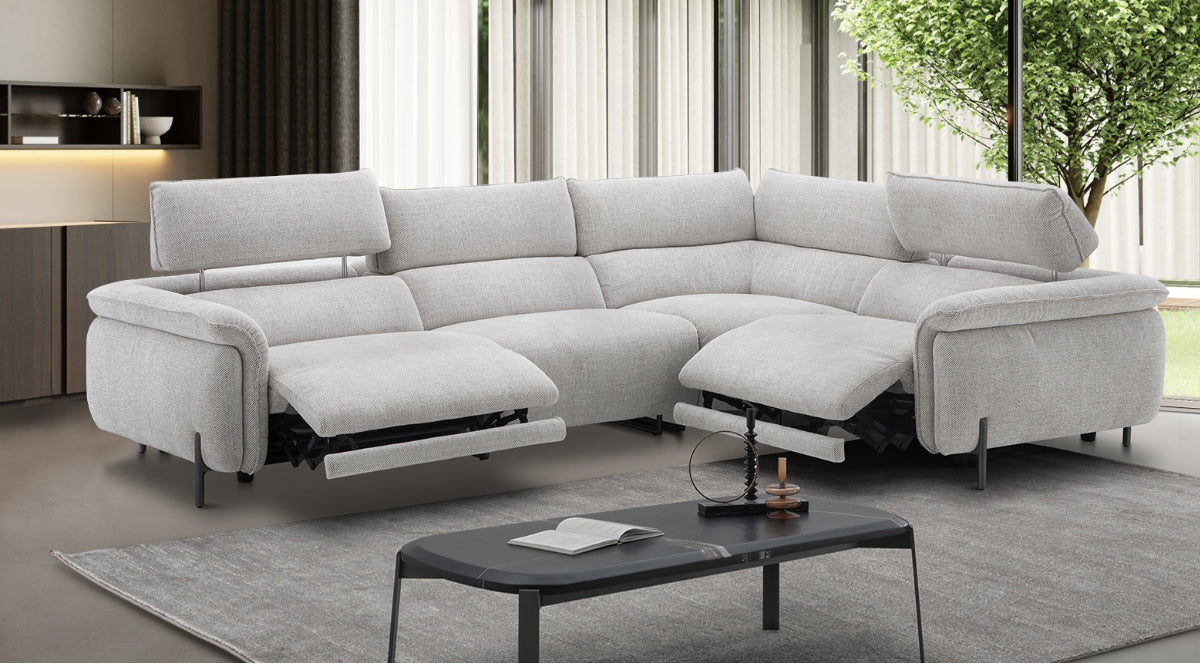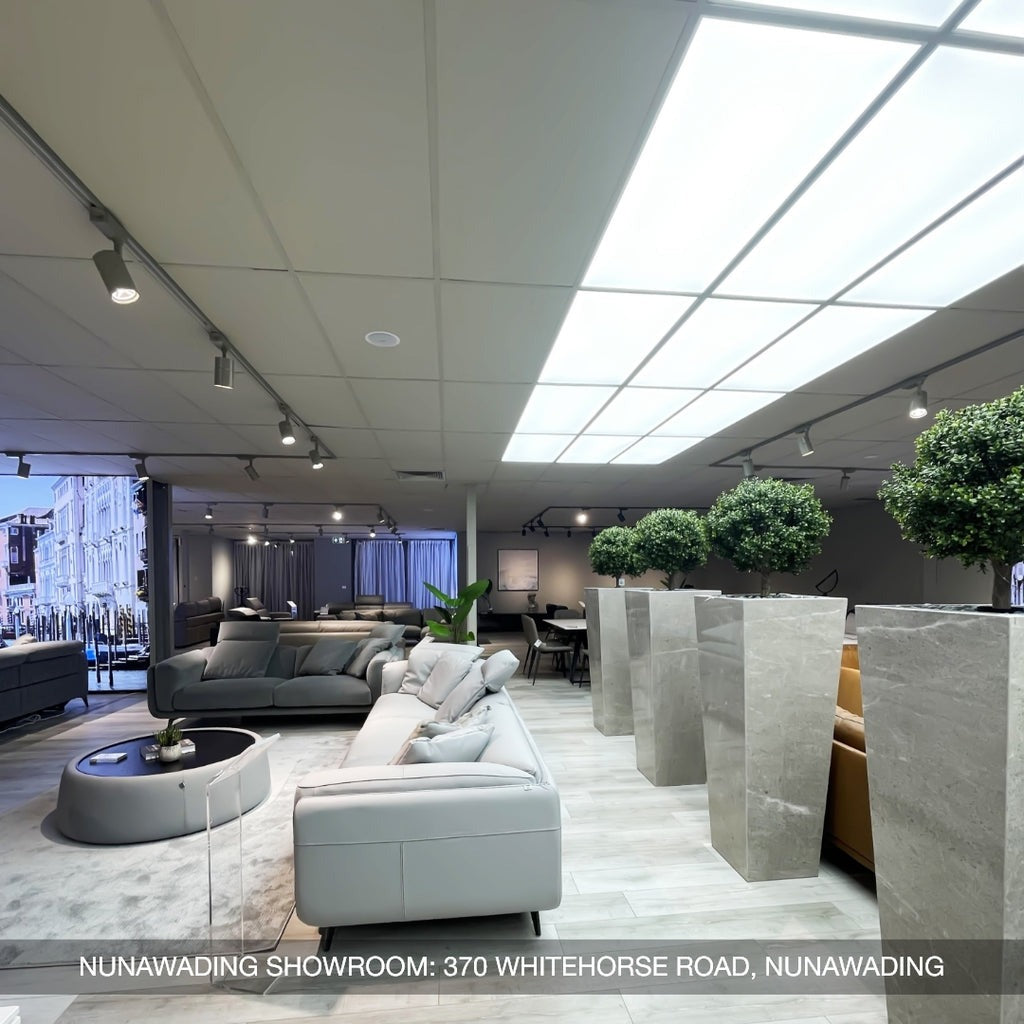The choice of material for your sofa or chair can dramatically impact the comfort, durability, and overall style of your living space. Among the most popular and debated options in interior design are leather and fabric, each offering its own unique appeal. Whether you’re captivated by the sleek elegance of a leather fabric sofa or the inviting warmth of a leather or fabric couch, choosing the right upholstery goes far beyond personal style, it’s a thoughtful decision that affects your comfort, lifestyle, and long-term satisfaction. We will explore the pros and cons of both materials to help you make an informed, stylish, and practical decision.
What Do You Know About Different Types of Leather and Fabric?
Some people love the warm, textured feel of fabric, while others prefer the sleek, timeless look of leather. To help you make the best choice for your home, this section will walk you through the different types of leather and fabric, beginning with leather.
Types of Leather: Not All Leather Is the Same
Not all leather is created equal. The quality, appearance, feel, and price of leather can vary significantly depending on how it's processed.
Full-Grain Leather
- Recognized as the highest quality leather, full-grain leather maintains its natural, unprocessed surface, complete with imperfections and grain patterns.
- Over time, it develops a rich natural patina, giving your furniture a beautifully aged, one-of-a-kind character.
- It's extremely durable and breathable, but also among the most expensive types—often featured in luxury furniture pieces.
Top-Grain Leather
- As the second-highest quality, top-grain leather is sanded and treated to remove surface imperfections, giving it a smoother, more uniform look.
- It is resistant to wear and tear, making it an excellent choice for households that want elegance and durability without the full-grain price tag.
Genuine Leather
- Despite the name, genuine leather is a lower-tier option made from the inner layers of animal hide.
- It offers a real leather feel and decent durability but doesn’t age as gracefully or breathe as well as full- or top-grain.
- Commonly found in mid-range furniture, it's a practical choice for those who want real leather at a more affordable price.
Bonded Leather
- Bonded leather is made by combining leftover leather fibers and scraps with polyurethane or other binding materials.
- It’s the most budget-friendly option but also the least durable, prone to peeling and cracking over time.
- Often used in budget furniture, it provides the look of leather without the longevity.
Faux Leather (PU/PVC Leather)
- Made from synthetic materials, faux leather is an animal-free alternative, ideal for vegan buyers.
- It’s water-resistant and easy to clean, making it a favorite for families with kids or pets.
- While less breathable and not as long-lasting as real leather, it mimics the look and feel quite well.
- Importantly, many modern faux leathers are marketed as eco-friendly, since they avoid animal products and can be produced with lower environmental impact. This makes them an attractive option for eco-conscious households seeking sustainable alternatives in the leather and fabric category.

Leather may look similar at first glance, but its quality, texture, durability, and cost can vary widely depending on how it’s processed.
Types of Fabric: A World of Textures and Styles
Fabric opens up a wide range of possibilities in terms of texture, color, and feel. In the ongoing fabric vs leather sofa discussion, fabric often stands out for its versatility and affordability, while leather wins points for its sleek, luxurious appeal. That said, understanding the types of fabrics available can help you decide whether a fabric and leather couch or a fully upholstered fabric option is best for your lifestyle.
Natural Fabrics
Natural fabrics are derived from plant or animal sources and are loved for their breathable, organic feel. They tend to offer a soft touch and natural aesthetic, making them a popular choice in casual or cozy interior spaces.
- Cotton is widely used due to its softness, breathability, and affordability. It’s comfortable for everyday use and available in countless colors and patterns. However, it does stain easily and may wear down faster than synthetic alternatives, especially in high-traffic areas.
- Linen is known for being lightweight, airy, and eco-friendly. It gives furniture a relaxed, breezy look that suits coastal or Scandinavian designs. That said, it tends to wrinkle easily and requires more care to keep it looking crisp.
- Wool offers a warm, durable option that resists pilling and retains its shape over time. It’s often blended with synthetic fibers for added strength. On the downside, it can be slightly itchy and is more commonly found in rugs or heavy upholstery pieces than everyday sofas.
- Silk brings a level of luxury and elegance unmatched by most fabrics. Its smooth texture and natural sheen add a sophisticated touch. However, it’s also delicate, prone to staining, and expensive, making it better suited for accent chairs or formal spaces rather than everyday use.
Synthetic Fabrics
Synthetic fabrics are man-made and engineered for enhanced durability, stain resistance, and color retention. These are often used in family homes, busy living rooms, or when practical concerns outweigh aesthetic preferences.
- Polyester is a strong, wrinkle-resistant material often blended with cotton for durability and colorfastness. It’s widely used in sofas due to its resistance to stretching and shrinking.
- Nylon is another durable, smooth-textured synthetic, often found in outdoor or performance fabrics. It holds up well under pressure but may pill over time when used alone.
- Acrylic mimics the softness and warmth of wool but is lighter and more moth-resistant. It resists fading and retains color well, making it a budget-friendly option for upholstery.
- Microfiber is one of the top choices for families and pet owners thanks to its ultra-soft feel and excellent stain resistance. It’s tightly woven, which makes it resistant to spills and easy to clean, perfect for everyday furniture like sofas and recliners.

Fabric offers endless variety in texture, color, and overall feel.
Leather vs Fabric Sofa: Which Material is Right for You?
Your sofa or chair always influences how your home feels, functions, and even how it reflects your personality. Choosing between leather and fabric may seem simple at first glance, but it's a decision that affects your comfort, maintenance routine, and overall interior vibe.
What Kind of Vibe Do You Want Your Space to Have?
Your sofa sets the tone for the entire room, so you should choose a material that matches the look and feel you’re going for.
- Leather: Sleek, clean, and refined, leather offers a timeless appeal perfect for modern, industrial, or luxury interiors. Black or brown leather sofas with exposed legs, for instance, can instantly elevate a minimalist space with a designer finish.
- Fabric: Soft, cozy, and inviting, fabric is ideal for homes that prioritize comfort and warmth. It blends beautifully with eclectic, casual, or family-oriented interiors. A fabric-upholstered 2 seater sofa, for example, feels more welcoming in smaller, personal spaces. Fabric also offers more variety in texture, pattern, and color, allowing for better customization.
How Much Time Do You Want to Spend on Cleaning?
Let’s be honest, not everyone has the time (or desire) to deep-clean their sofa every week. That’s why understanding each material’s maintenance needs is crucial.
- Leather: Low-maintenance and stain-resistant, leather can be quickly cleaned with a simple wipe-down using a damp cloth. However, it does require occasional conditioning to maintain softness and prevent cracking over time. For busy professionals or families who value easy care, leather sofas offer a major advantage.
- Fabric: Requires regular vacuuming and spot cleaning, especially in homes with pets, kids, or high foot traffic. Fabric is generally more prone to absorbing odors and spills, though some modern weaves are treated with stain-repellent finishes. If you opt for fabric, consider removable covers for ease of washing or go with a leather and fabric hybrid design, leather in high-contact areas, fabric on the cushions, for a balanced maintenance load.
Who Will Be Using the Sofa or Chair Daily?
The people who use your furniture most often can significantly influence the best material choice for your lifestyle.
Families with Kids or Pets
- Leather: It’s easy to clean leather sofa and doesn’t hold onto pet hair or spills, making it ideal for active households. However, leather can scratch easily, especially with pets that have sharp claws.
- Fabric: Though more susceptible to staining, fabric can be protected with washable covers or treated finishes, and cushion covers can often be replaced without buying a new sofa.
Elderly or Guests
- Fabric: Typically softer and warmer, fabric seats are gentler on sensitive skin and joints, making them ideal for older adults.
- Leather: While elegant, it may feel cold in winter or sticky in summer, which can be uncomfortable for some users. Choosing a leather and fabric sofa allows you to balance style and temperature comfort, depending on how the piece is used.

The people who use your sofa or chair most often should play a major role in choosing the right material.
Are You Looking for Long-Term Value or Short-Term Flexibility?
Understanding your priorities, whether it’s investing for the long haul or staying flexible with your home style will influence which material makes the most sense.
- Leather: Offers excellent long-term value. High-quality leather, especially full-grain or top-grain, can last 10 - 20 years or more with proper care. Though it requires a larger upfront investment, its durability means it doesn't need to be replaced as frequently, which can actually save money over time.
- Fabric: Generally more affordable, making it ideal for short-term living situations or evolving design tastes. Easier to update or replace as trends or personal preferences change, perfect for renters or first-time buyers who want flexibility. Fabric slipcovers or modular styles also allow quick refreshes without buying a new sofa.
Do You Have Allergies or Sensitivities?
Health and air quality are crucial considerations, especially if you or your family members suffer from allergies.
- Leather: Naturally hypoallergenic. Its smooth surface doesn’t trap dust, pollen, or pet dander, making it easier to keep allergen-free. Ideal for households with sensitive individuals or respiratory concerns.
- Fabric: Can collect allergens such as dust mites, pollen, and pet hair, especially if not cleaned regularly. However, vacuuming with HEPA filters and using removable, washable covers can greatly reduce allergens and improve indoor air quality.
What’s Your Stance on Sustainability and Ethics?
If you're concerned about the ethical and environmental impact of your furniture, this is a key area where material choice matters.
- Leather: Traditional leather raises concerns about animal welfare, water usage, and chemical tanning processes. That said, more brands are now offering recycled leather, plant-based leather, and vegetable-tanned options, which reduce environmental impact. As sustainable innovation increases, leather options are becoming more ethical and eco-conscious than ever.
- Fabric: Offers a wider range of sustainable choices, including organic cotton, hemp, bamboo, and recycled synthetics. Low-impact dyes and eco-friendly production processes make fabric more appealing to environmentally conscious consumers. Many brands now prioritize certified sustainable textiles, giving shoppers peace of mind.
How about Budget?
While appearance and comfort are important, your budget will often determine what’s realistic.
- Leather: Typically more expensive upfront, especially full-grain or top-grain varieties. However, because of its longevity and durability, leather can offer better value over time, especially if you plan to keep the piece for many years. Entry-level options like bonded or faux leather can provide the look without the price tag, though they wear out faster.
- Fabric: More budget-friendly in most cases, with a wide range of price points based on quality and brand. Offers better flexibility for people who want to invest in multiple pieces or change decor more often. Even high-performance or designer fabric sofas tend to be cheaper than premium leather models.

While it comes with a higher initial cost, leather's durability and resistance to wear mean fewer replacements over time, making it a smart, cost-effective investment in the long run.
Final Thoughts: Tailor Your Choice to Your Life
There’s no one size fits all answer. Truthfully, there’s no such thing as “the best material”, only “the most suitable one.” Your decision should reflect your personal lifestyle, household dynamics, aesthetic preferences, and practical needs. Despite you're furnishing a busy family room, a minimalist apartment, or a sophisticated lounge area, choosing between leather and fabric isn’t about following trends, it’s about finding what works best for you.
- If you value elegance, longevity, and easy maintenance, leather may be your ideal fit. It works beautifully in modern, formal, or minimalist spaces and provides strong long-term value. Full-grain leather, in particular, adds richness and a natural patina that improves over time.
- If you prefer warmth, variety, and softness, fabric is likely your better match. It suits cozy, casual, and colorful interiors where comfort and character take priority. With countless textures and tones available, fabric offers more flexibility for evolving tastes and seasonal updates.
In the end, choosing between leather and fabric comes down to your personal lifestyle, preferences, and how you use your space. Each material offers unique advantages, leather for its timeless elegance and durability, fabric for its warmth, variety, and comfort. You’ll find a wide range of premium leather and fabric sofas and chairs designed for both style and everyday living at COZY's showroom. Visit COZY today to explore high-quality options that bring lasting beauty and comfort into your home.





